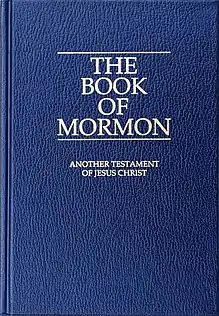| Part of a series on the |
| Book of Mormon |
|---|
 |

Moroni (/məˈroʊnaɪ/), according to the Book of Mormon, was the last Nephite prophet, historian, and military commander who lived in the Americas in the late fourth and early fifth centuries. He is later known as the Angel Moroni, who presented the golden plates to Joseph Smith, who translated the plates upon which the Book of Mormon was originally written.
Early life
According to the Book of Mormon, Moroni was the son of Mormon,[1] the prophet for whom the Book of Mormon is named. Moroni shares a name with Captain Moroni, a much earlier Book of Mormon figure, of whom Mormon wrote highly.[2]
The Book of Mormon states that Moroni served under his father, the commander in chief of 23 groups of about 10,000 Nephites each,[3] who battled against the Lamanites. Upon the Nephites' defeat at Cumorah, Moroni was forced to go into hiding and to wander from place to place to avoid being killed by the Lamanites. Moroni was the last known survivor of the Nephite nation.
Moroni had been commanded by his father to complete the Nephite record, which Mormon had abridged from previous records. Moroni is the ascribed author of chapters 8 and 9 of Mormon's record within the larger Book of Mormon, the entire Book of Moroni, and the Title Page of the Book of Mormon. He also added the Book of Ether to the plates, which is primarily an abridgment of Jaredite writings, but also contains extensive commentary by Moroni, especially in Ether 4, Ether 5, Ether 8, and Ether 12. Moroni was the last prophet to write in the Book of Mormon.
Moroni then writes that he had spoken to Jesus and received extensive visions of the future. Speaking directly to modern-day readers of the Book of Mormon, Moroni writes, "Behold, I speak unto you as if ye were present, and yet ye are not. But behold, Jesus Christ hath shown you unto me, and I know your doing".[4]
Upon completion of the record, written on golden plates, Moroni is said to have buried the plates in a stone box in a hill in what is now Wayne County, New York, from where Joseph Smith reported that he recovered them; a 12-m granite and bronze monument to Moroni has been placed by the Church of Jesus Christ of Latter-day Saints on this hill.
According to Charles Tate Jr and Monte S. Nymon of the BYU Religious Studies Center, there has been found only one account which speaks of Moroni's physical death:
"At a meeting at Spanish Fork, Utah Co., in the winter of 1896, Brother Higginson stated in my presence that Thomas B. Marsh told him that the Prophet Joseph Smith told him (Thomas B. Marsh, he being then President of the Twelve), that he became very anxious to know something of the fate of Moroni, and in answer to prayer the Lord gave Joseph a vision, in which appeared a wild country and on the scene was Moroni after whom were six Indians in pursuit; he stopped and one of the Indians stepped forward and measured swords with him. Moroni smote him and he fell dead; another Indian advanced and contended with him; this Indian also fell by his sword; a third Indian then stepped forth and met the same fate; a fourth afterwards contended with him, but in the struggle with the fourth, Moroni, being exhausted, was killed. Thus ended the life of Moroni." (Evans)
Afterlife
In Latter Day Saint belief, Moroni was resurrected after his death and became an angel who directed Joseph Smith to the location of the buried golden plates in the 1820s.[5]
See also
- Moroni, Utah named for him.
References
- ↑ Mormon 6:6
- ↑ Alma 48:11–17
- ↑ Mormon 6:10–15
- ↑ Mormon 8:35
- ↑ Smith, Joseph Jr. (July 1838), "Editor's note", Elders' Journal of the Church of Jesus Christ of Latter Day Saints, 1 (3): 42–43.
Further reading
- Hatch, Gary L. (1995). "Mormon and Moroni: Father and Son". In Nyman, Monte S.; Tate, Charles D., Jr. (eds.). Fourth Nephi, From Zion to Destruction. Provo, Utah: Religious Studies Center, Brigham Young University. pp. 105–15. ISBN 0-88494-974-5. OCLC 32500560.
{{cite book}}: CS1 maint: multiple names: editors list (link) - Peterson, H. Donl (1995). "Moroni, the Last of the Nephite Prophets". In Nyman, Monte S.; Tate, Charles D., Jr. (eds.). Fourth Nephi, From Zion to Destruction. Provo, Utah: Religious Studies Center, Brigham Young University. pp. 235–49. ISBN 0-88494-974-5. OCLC 32500560.
{{cite book}}: CS1 maint: multiple names: editors list (link) - Peterson, H. Donl (1992), "Moroni2 [Son of Mormon]", in Ludlow, Daniel H (ed.), Encyclopedia of Mormonism, New York: Macmillan Publishing, pp. 956–957, ISBN 0-02-879602-0, OCLC 24502140
- Romney, Joseph B. (1992), "Moroni, Angel", in Ludlow, Daniel H (ed.), Encyclopedia of Mormonism, New York: Macmillan Publishing, p. 953, ISBN 0-02-879602-0, OCLC 24502140
- References to Moroni2, Index, Book of Mormon (LDS edition)
H. Donl Peterson, "Moroni, the Last of the Nephite Prophets," in Fourth Nephi, From Zion to Destruction, ed. Monte S. Nyman and Charles D. Tate Jr. (Provo, UT: Religious Studies Center, Brigham Young University, 1995), 235–49.
External links
- The text of Moroni at Wikisource.